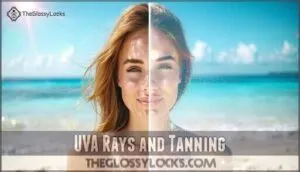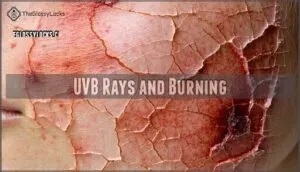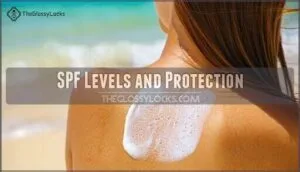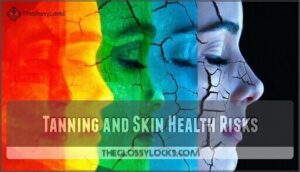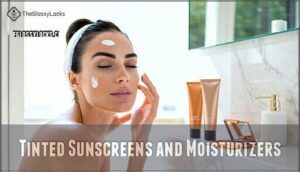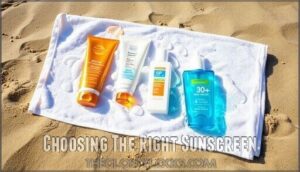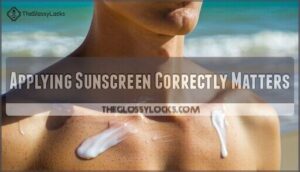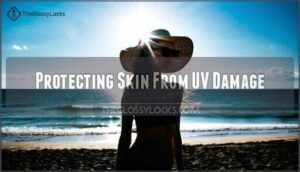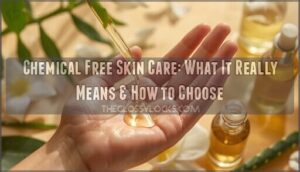This site is supported by our readers. We may earn a commission, at no cost to you, if you purchase through links.
 Yes, you can tan with sunscreen on, but it’s like having a safety net while walking a tightrope.
Yes, you can tan with sunscreen on, but it’s like having a safety net while walking a tightrope.
No sunscreen blocks 100% of UV rays, so some still penetrate to darken your skin. However, you’ll tan more slowly and safely compared to going bare.
SPF 30 blocks about 97% of UV radiation, while SPF 50 stops roughly 98%.
This means you’re still getting that golden glow, just without the painful burn that comes from overexposure. Your skin builds melanin gradually, creating a more even, longer-lasting tan.
The secret lies in understanding how different SPF levels affect your tanning timeline and choosing the right protection.
Table Of Contents
- Key Takeaways
- Sunscreen and Tanning Basics
- Can You Tan With Sunscreen
- How SPF Affects Tanning
- Tanning and Skin Health Risks
- Safe Tanning Alternatives Exist
- Choosing The Right Sunscreen
- Applying Sunscreen Correctly Matters
- Protecting Skin From UV Damage
- Frequently Asked Questions (FAQs)
- Can you get a tan with sunscreen?
- Which SPF is best for tanning?
- Do you tan quicker without sunblock?
- Why do I tan so quickly even with sunscreen?
- Can you get a tan using sunscreen?
- What SPF is best for tanning?
- Can you tan without damaging your skin?
- Is it OK to tan with no sunscreen?
- How often should sunscreen be reapplied tanning?
- Does sunscreen affect the intensity of tan achieved?
- Conclusion
Key Takeaways
- You can still tan with sunscreen on, but it happens more slowly and safely since even SPF 30 allows about 3% of UV rays to reach your skin and trigger melanin production.
- Higher SPF levels provide better protection but don’t completely prevent tanning – SPF 30 blocks 97% of rays while SPF 50 blocks 98%, so you’ll develop color gradually over time.
- You must apply sunscreen correctly to maintain protection – use two tablespoons for your whole body, apply 15-30 minutes before sun exposure, and reapply every two hours or after swimming and sweating.
- Any tan represents DNA damage to your skin cells, so while you can tan with sunscreen, it’s safer to choose alternatives like tinted sunscreens or self-tanners to avoid long-term skin cancer and aging risks.
Sunscreen and Tanning Basics
You’ve likely wondered whether you can still get a tan while wearing sunscreen, and the answer involves understanding how sunscreen interacts with ultraviolet radiation.
Sunscreen creates a protective barrier that blocks most UV rays, but it doesn’t completely prevent all sun exposure, which means some tanning can still occur depending on factors like SPF level and application method.
How Sunscreen Works
Sunscreen creates a protective barrier against harmful UV rays through two main mechanisms.
Mineral sunscreens use zinc oxide and titanium dioxide for UV reflection, bouncing radiation away from your skin.
Chemical sunscreens work through UV absorption, triggering chemical reactions that convert UV energy into heat dispersion.
Both types prevent sunburn by blocking damaging radiation before it penetrates your skin’s surface, utilizing UV reflection and UV absorption to safeguard the skin.
Types of UV Rays
When you step outside, two types of UV rays target your skin with different destructive powers.
Understanding these invisible threats helps you make smarter sunscreen choices for safer tanning.
Here’s what you’re facing:
- UVA rays cause deep UVA penetration, triggering the tanning mechanism through cellular stress
- UVB rays deliver immediate UVB effects like painful sunburns
- Both types contribute to serious UV damage over time
- UVA wavelengths penetrate glass and clouds consistently
- UVB intensity varies by season and location
Skin Damage From UV Rays
UV rays consistently wreak havoc on your skin at the cellular level, triggering DNA damage that accumulates over time.
UVA penetration causes premature skin aging, while UVB exposure creates immediate sunburn risk and long-term melanoma development.
Tanning consequences include permanent cellular damage, increased skin cancer risk, and accelerated aging that no amount of moisturizer can reverse.
A good skincare routine can help with reversing sun damage.
Can You Tan With Sunscreen

Yes, you can still tan with sunscreen, though the process becomes slower and more controlled.
Sunscreen effectiveness doesn’t completely block all UV rays—even SPF 30 allows about 3% of UVB radiation to reach your skin.
This remaining UV exposure triggers melanin production, the biological process responsible for skin darkening.
Your skin gradually develops color over time, but sunscreen limitations mean you’re getting substantially less radiation than going unprotected.
The reality about tanning with sunscreen includes these key points:
- Gradual tanning still occurs despite sunscreen protection
- Melanin production continues at reduced levels with proper SPF use
- Sunscreen tanning takes longer but causes less cellular damage
- Can you tan safely? Only with consistent broad-spectrum protection
- Tanning with SPF provides some defense against burning while allowing color development
How SPF Affects Tanning
SPF ratings directly influence your ability to tan by determining how much UV radiation reaches your skin, with higher SPF levels blocking more rays and reducing tanning potential.
While SPF 15 allows approximately 7% of UVB rays through, SPF 30 permits only 3%, meaning you’ll tan more slowly but can still develop color with proper sun exposure and reapplication.
UVA Rays and Tanning
UVA rays slip through most sunscreens like uninvited guests, triggering melanin production that creates your tan.
These deep-penetrating rays cause cumulative damage and aging effects that you can’t reverse.
While sunscreen protection reduces UVA penetration, your tanning response continues at a slower pace.
Even with diligent sunscreen tanning habits, UVA rays still reach your skin’s deeper layers, which is why it’s recommended to use broad-spectrum sunscreen for maximum safety and to prevent aging effects.
UVB Rays and Burning
Unlike UVA rays that gradually darken your skin, UVB rays pack a more immediate punch.
These high-energy rays target your skin’s surface, triggering the inflammatory response you know as sunburn.
When UVB intensity overwhelms your natural defenses, you’ll experience the telltale signs of overexposure.
Here’s what happens when UVB rays hit unprotected skin:
- Skin redness appears within hours as blood vessels dilate in response to UV damage
- Sunburn severity ranges from mild pink tones to deep red inflammation requiring pain management
- Blistering effects occur when UVB penetration causes severe tissue damage beneath the surface
- UV rays continue damaging cells even after you’ve left the sun, prolonging discomfort
- Skin burns peak 12-24 hours after exposure, with peeling following as your body sheds damaged cells
Sunscreen blocks most UVB radiation, preventing this painful cycle from starting.
SPF Levels and Protection
Higher SPF levels provide incrementally better sun protection, but many people harbor SPF misconceptions about their effectiveness.
SPF 30 blocks 97% of UV rays while SPF 50 filters 98% – a modest difference.
Broad-spectrum importance can’t be overstated since it protects against both UVA and UVB radiation.
Regular SPF reapplication every two hours maintains maximum sunscreen coverage regardless of rating.
Tanning and Skin Health Risks
While you might think tanning gives you a healthy glow, UV exposure actually triggers your skin’s damage response and accelerates aging processes.
Understanding these health risks helps you make informed decisions about sun protection and recognize that any tan represents permanent cellular damage to your skin, which is a result of the skin’s damage response.
Premature Aging and Wrinkles
UV damage from tanning accelerates collagen breakdown and elastin loss, creating visible photoaging effects years before natural aging occurs.
Your skin’s structural proteins deteriorate under repeated sun exposure, causing deep wrinkles and sagging.
Sunscreen serves as your primary defense against premature aging by blocking harmful rays.
Prevention methods like consistent SPF use maintain youthful skin appearance longer.
Limiting exposure reduces the risk of acute skin effects like sunburn.
Prevention is key to maintaining healthy skin, and using sunscreen is a crucial step in preventing photoaging effects.
Skin Cancer and Melanoma
Your skin cells face a stark reality when exposed to UV radiation without proper protection.
Your skin remembers every unprotected moment in the sun, storing each UV assault as permanent cellular damage.
Tanning dramatically increases melanoma risk, with 90% of skin cancer cases stemming from UV exposure.
Genetic predisposition amplifies this danger, making sunscreen your first line of defense.
Early detection through regular skin checks and melanoma prevention strategies can save your life when treatment options matter most.
Vitamin D Production and Tanning
Your body produces vitamin D through UV ray exposure, but sunscreen can interfere with this natural synthesis process.
However, you don’t need extensive tanning or sun exposure to maintain adequate vitamin D levels.
Safe alternatives include dietary sources like fortified foods and fish, plus supplementation options recommended by healthcare providers.
Brief, protected sun exposure provides sufficient vitamin D without dangerous tanning risks.
Many people prefer tanning oils with SPF for safer sun exposure, using tanning oils and opting for protected sun.
Safe Tanning Alternatives Exist
You don’t have to choose between protecting your skin and achieving that sun-kissed look you’re after.
Several effective alternatives can give you a bronzed appearance while keeping your skin safe from harmful UV damage.
Tinted Sunscreens and Moisturizers
Tinted sunscreens offer the perfect compromise between sun protection and that coveted sunkissed glow.
These innovative products combine UV defense with subtle color enhancement, eliminating the need for separate foundation applications.
Consider these tinted benefits for your daily routine:
- Coverage levels range from sheer to medium, matching various skin tones
- Moisturizer compatibility allows seamless layering with existing skincare
- Ingredient safety meets dermatological standards for sensitive skin
- Sunscreen application becomes effortless with built-in color correction
- Sun protection maintains SPF effectiveness while providing natural-looking coverage
Many users appreciate the convenience of tinted sunscreens.
Protective Clothing and Accessories
Beyond sunscreen, sun protective clothing creates your first line of defense against harmful rays.
Clothing materials with tight weaves block UV radiation effectively, while UV fabric technology offers enhanced protection. You can explore options for clothing with UV protection.
Widebrimmed hats provide essential hat coverage for your face and neck. Quality sunglasses shield delicate eye areas.
Sun hats and sun glasses together maximize accessory effectiveness for thorough protection.
Choosing The Right Sunscreen
You’ll want to select a broad-spectrum sunscreen with SPF 30 or higher that protects against both UVA and UVB rays, as these provide the most thorough protection for your skin.
Consider whether you need mineral sunscreens with zinc oxide or titanium dioxide for sensitive skin, or chemical formulations that absorb UV radiation.
Look for water-resistant options if you’ll be swimming or sweating.
Mineral Vs Chemical Sunscreens
Understanding your sunscreen options helps you make informed choices for ideal sun protection.
Here’s how mineral and chemical sunscreens differ in their approach to UV defense:
- Mineral Safety – Zinc oxide and titanium dioxide create physical barriers that reflect UV rays off your skin
- Chemical Absorption – Avobenzone and oxybenzone absorb UV energy, converting it to heat within skin cells
- Environmental Impact – Mineral formulas prove reef-safe while some chemical ingredients harm marine ecosystems
- Skin Sensitivity – Mineral sunscreens cause fewer allergic reactions than chemical alternatives
- Efficacy Comparison – Both types provide effective SPF protection when applied correctly
Chemical sunscreens blend invisibly but may irritate sensitive skin, while mineral sunscreens offer gentler protection with potential white residue.
You can find a variety of mineral sunscreen products online.
Broad-Spectrum and Water-Resistant Options
Broad-spectrum sunscreens protect against both UVA and UVB rays, offering thorough coverage that prevents tanning and burning.
Water-resistant formulas maintain protection during swimming or sweating for specified durations—typically 40 or 80 minutes.
These filter combinations prove especially valuable for active lifestyles. However, reapplication importance remains paramount regardless of water-resistance claims, as no sunscreen provides indefinite protection during extended activity levels.
SPF 30 or Higher for Daily Use
Dermatologists consistently recommend SPF 30 as your daily minimum for effective sun protection and sunburn prevention.
This level blocks approximately 97% of harmful UVB rays while allowing controlled tanning through remaining radiation.
- Daily SPF Benefits: Prevents premature aging and maintains healthy skin year-round
- Broad-Spectrum Importance: Protects against both UVA and UVB radiation damage
- Reapplication Frequency: Every two hours maintains consistent sunscreen effectiveness
- Year-Round Use: Essential protection regardless of season or weather conditions
- Skin Type: Choose formulas matching your specific dermatological needs
Applying Sunscreen Correctly Matters
You can’t achieve effective sun protection if you don’t apply sunscreen properly, regardless of the SPF rating on the bottle.
Inadequate application reduces your protection below the labeled SPF level, which increases your risk of both sunburn and the gradual tanning that indicates UV damage to your skin, ultimately affecting your overall protection.
Reapplication Every 2 Hours
Sunscreen protection fades throughout the day, making consistent protection impossible without regular reapplication.
You’ll need to reapply every two hours to maintain effectiveness against UV rays.
Sweat impact and water activities accelerate this timeline, requiring more frequent application for maximum sun protection.
A vital step involves prioritizing broad-spectrum sunscreen for maximum protection.
| Activity Type | Reapplication Frequency | SPF Consideration |
|---|---|---|
| Beach/Pool | Every 60-90 minutes | Water-resistant formula |
| Daily Outdoor | Every 2 hours | Standard broad-spectrum |
| Sports/Exercise | Every hour | Sweat-resistant options |
The reapplication frequency depends on the type of activity, with beach/pool activities requiring reapplication every 60-90 minutes, daily outdoor activities every 2 hours, and sports/exercise every hour, to ensure maximum protection.
Using Enough Sunscreen for Coverage
Most people apply only 25-50% of the recommended sunscreen amount, dramatically reducing SPF protection.
You need two tablespoons for your entire body – that’s about a shot glass full.
Think of it like frosting a cake: coverage amount matters for even application.
Don’t forget missed spots like ears, feet, and behind your neck where UV rays sneak through.
Applying Before Sun Exposure
Timing matters when building your pre-exposure routine.
Apply sunscreen 15-30 minutes before stepping outside to allow proper skin absorption. This window guarantees adequate amount coverage takes effect before UV rays hit.
Even application across all exposed areas prevents patchy protection.
Many people wonder "can you tan with sunscreen" – proper timing helps maximize SPF for tanning while maintaining protection against harmful damage.
Protecting Skin From UV Damage
You’ll need thorough protection beyond sunscreen to effectively shield your skin from harmful UV radiation that causes premature aging, wrinkles, and skin cancer.
Strategic timing of outdoor activities, protective clothing choices, and regular dermatological screenings work together to create a complete defense system against long-term UV damage.
Limiting Sun Exposure Times
Strategic timing transforms your sun protection game. Peak UV hours between 10 AM and 3 PM deliver the strongest radiation, making shade seeking strategies essential during these dangerous windows.
Time-of-day tanning considerations:
- Morning exposure (7-10 AM) – Gentler rays allow longer sun exposure with reduced burning risk
- Midday avoidance (10 AM-3 PM) – UV intensity peaks, requiring maximum SPF and shade
- Late afternoon (3-6 PM) – Moderate radiation levels permit cautious outdoor activities
- Indoor UV exposure – Windows block UVB but allow UVA penetration
- Sun exposure duration – Limit sessions to 15-30 minutes even with sunscreen protection
Wearing Protective Gear and Clothing
Beyond timing your outdoor activities, clothing UV protection forms your second line of defense against harmful rays.
Wide-brimmed hats provide sun coverage for your face and neck, while UV-blocking sunglasses protect delicate eye areas.
Choose tightly woven fabric types over loose weaves for maximum protection, as sun-protective gear complements sunscreen, creating thorough sunsafe practices that shield your skin effectively.
Annual Dermatologist Skin Checks
Regular professional exams with dermatologists provide essential cancer screening that your mirror can’t match.
Early detection through preventative care dramatically improves treatment outcomes when skin cancer develops despite consistent sunscreen use. Reversing sun damage can be achieved through various treatments.
What dermatologists check during skin examinations:
- Mole monitoring – documenting size, shape, and color changes over time
- Hard-to-see areas – scalp, back, and between toes where self-checks miss spots
- Suspicious lesions – identifying irregular borders, asymmetry, or unusual pigmentation patterns
- Previous problem areas – tracking locations with prior abnormal findings or treatments
- Skin cancer detection – using specialized tools and training for accurate diagnosis
Frequently Asked Questions (FAQs)
Can you get a tan with sunscreen?
Yes, you can still get a tan while wearing sunscreen.
Sunscreen slows down tanning by blocking most UV rays, but some radiation still penetrates, allowing gradual skin darkening while reducing burn risk, which involves gradual skin darkening.
Which SPF is best for tanning?
Ironically, seeking the "best" SPF for tanning defeats sunscreen’s purpose. Lower SPFs like 15-30 allow more UV penetration, enabling gradual tanning while providing some protection against burns and long-term damage.
Do you tan quicker without sunblock?
Without sunblock, you’ll tan faster because your skin receives full UV exposure, triggering rapid melanin production.
However, this unprotected exposure substantially increases sunburn risk and long-term skin damage, including premature aging and cancer.
Why do I tan so quickly even with sunscreen?
Ever wonder why your skin still darkens despite diligent sunscreen use?
You’re likely experiencing breakthrough UV radiation that penetrates your protective barrier, triggering melanin production even when you’re following proper sun safety protocols consistently.
Can you get a tan using sunscreen?
You can still develop a tan while wearing sunscreen, though it’ll happen more slowly.
Sunscreen blocks most UV rays but doesn’t create a complete barrier, allowing some radiation through to stimulate melanin production.
What SPF is best for tanning?
Here’s the truth: no SPF is "best" for tanning because any deliberate tanning damages your skin.
SPF 30 blocks 97% of rays while SPF 15 blocks 93%, but both still allow harmful UV penetration that accelerates aging.
Can you tan without damaging your skin?
No, you can’t achieve a "safe tan" from sun exposure.
Tanning signals DNA damage to your skin cells, regardless of precautions taken.
Any darkening means your skin is defending against harmful UV radiation.
Is it OK to tan with no sunscreen?
Playing with fire describes tanning without sunscreen perfectly.
You’re exposing yourself to dangerous UV radiation that causes cellular damage, premature aging, and substantially increases your skin cancer risk.
It’s never safe.
How often should sunscreen be reapplied tanning?
You should reapply sunscreen every two hours when tanning, or immediately after swimming, sweating, or toweling off.
This maintains protection against harmful UV rays while allowing gradual tanning to occur safely.
Does sunscreen affect the intensity of tan achieved?
Sunscreen substantially slows your skin’s tanning process by blocking UV rays that trigger melanin production.
You’ll still develop some color over time, but it’ll be much lighter and take considerably longer than unprotected exposure, which can be influenced by the use of sunscreen.
Conclusion
Think of sunscreen as your skin’s personal bodyguard – it doesn’t eliminate all threats, but it substantially reduces harm.
Yes, you can tan with sunscreen on, though the process occurs more gradually and safely.
SPF 30 blocks 97% of UV rays, allowing controlled melanin production while preventing burns.
Choose broad-spectrum protection, apply generously, and reapply every two hours.
Remember, any tan indicates DNA damage, so prioritize skin health over appearance.
Your future self will thank you for this protection.
- https://www.ncbi.nlm.nih.gov/books/NBK587264/
- https://link.springer.com/article/10.1007/s10311-023-01649-4
- https://www.skincancer.org/skin-cancer-prevention/sun-protection/sunscreen/
- https://www.scielo.br/j/bjps/a/4kkFt39DQzrhqXW7bJSxhJQ/?format=pdf&lang=en
- https://www.sciencedirect.com/science/article/pii/S1319016419301033

